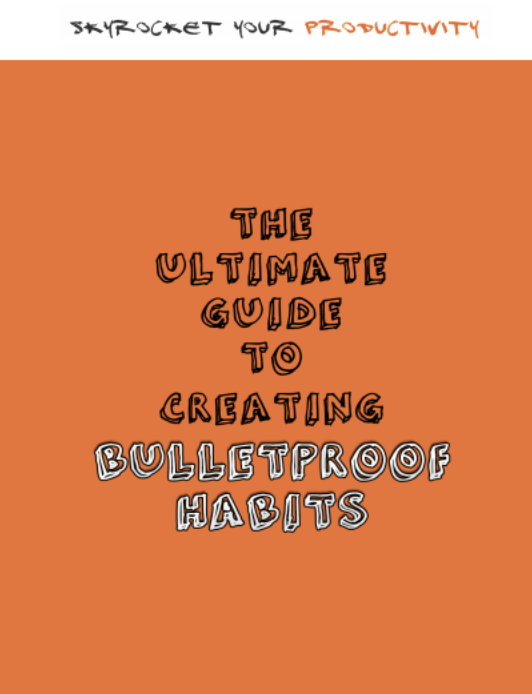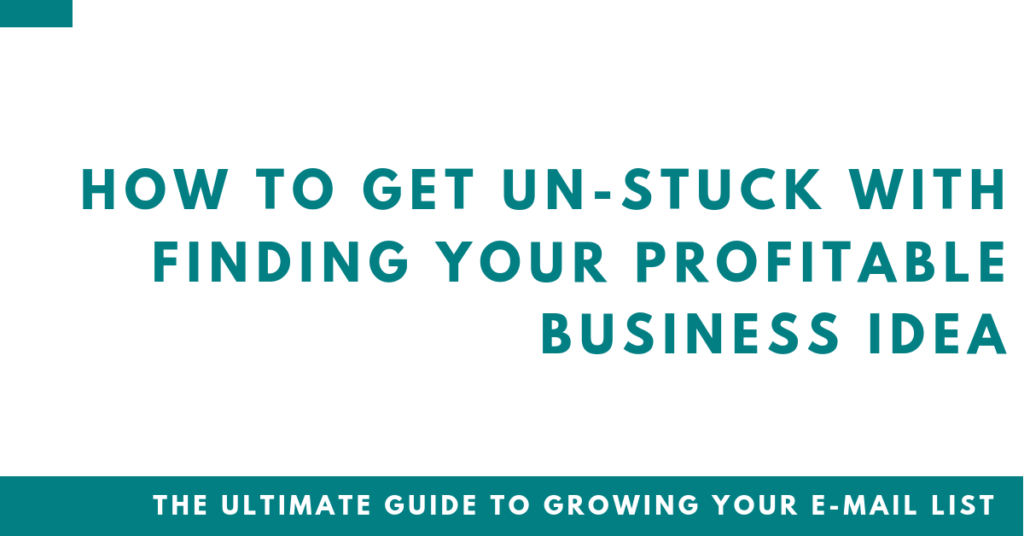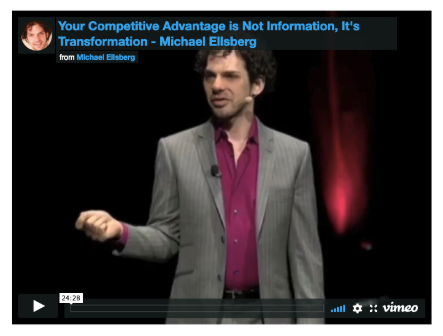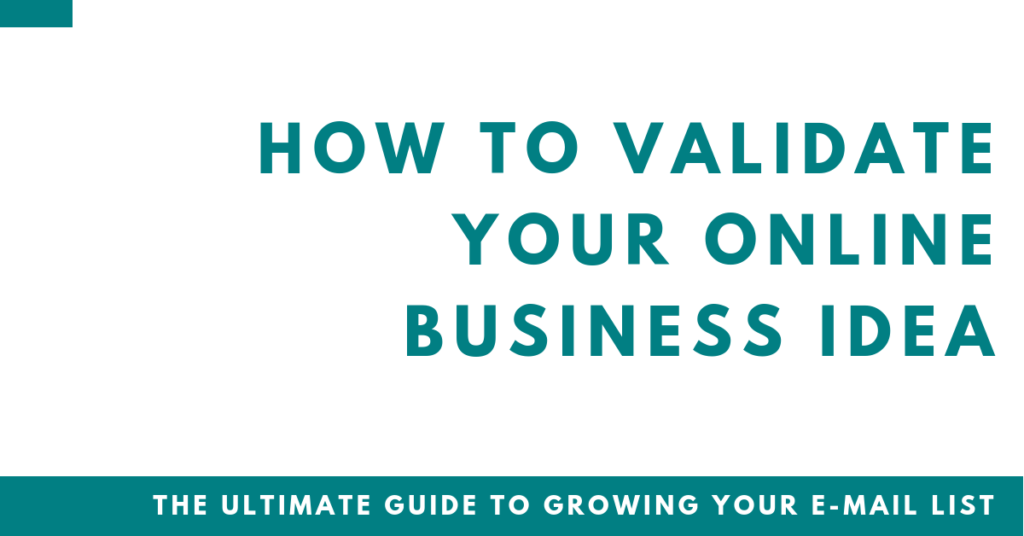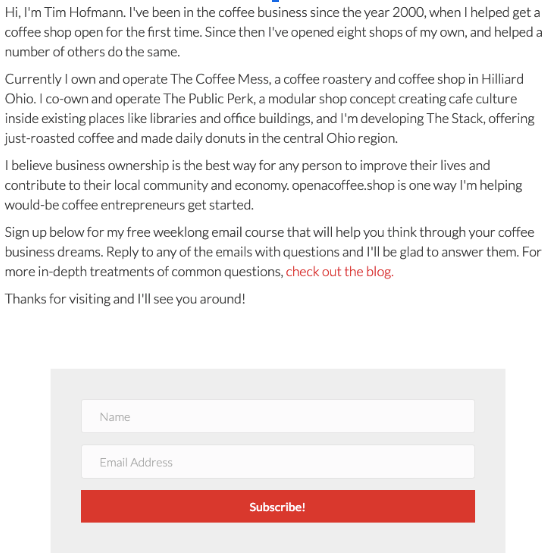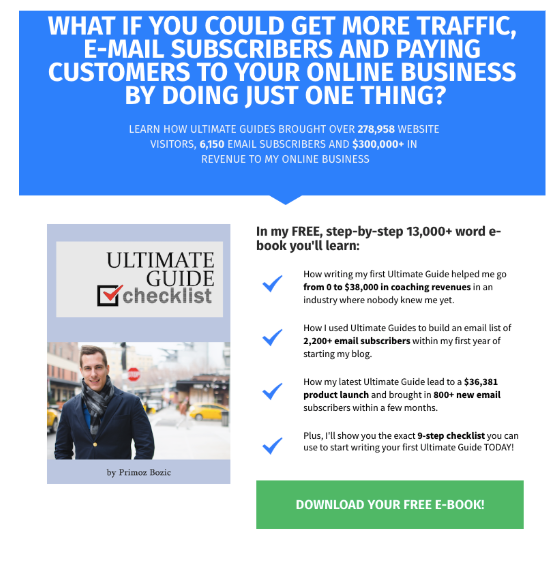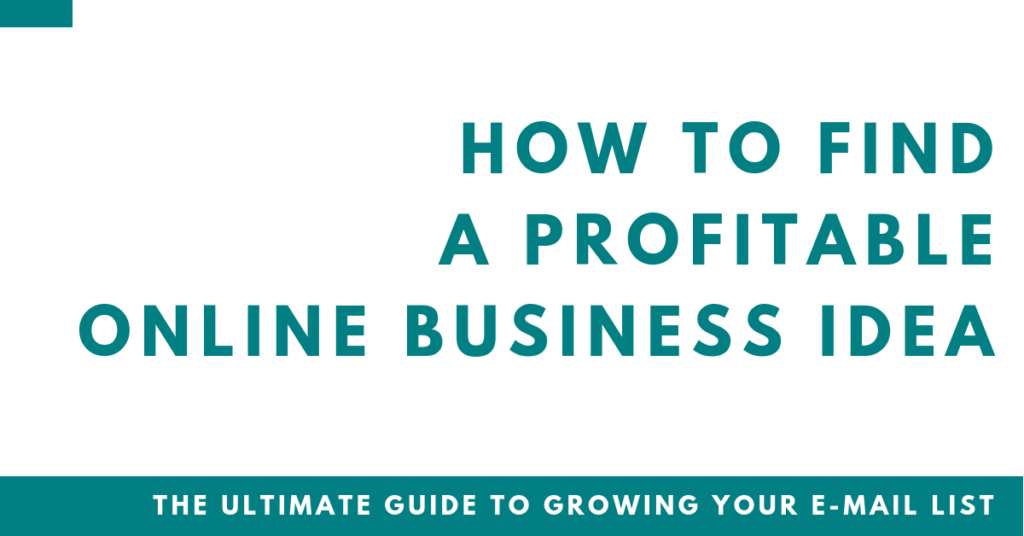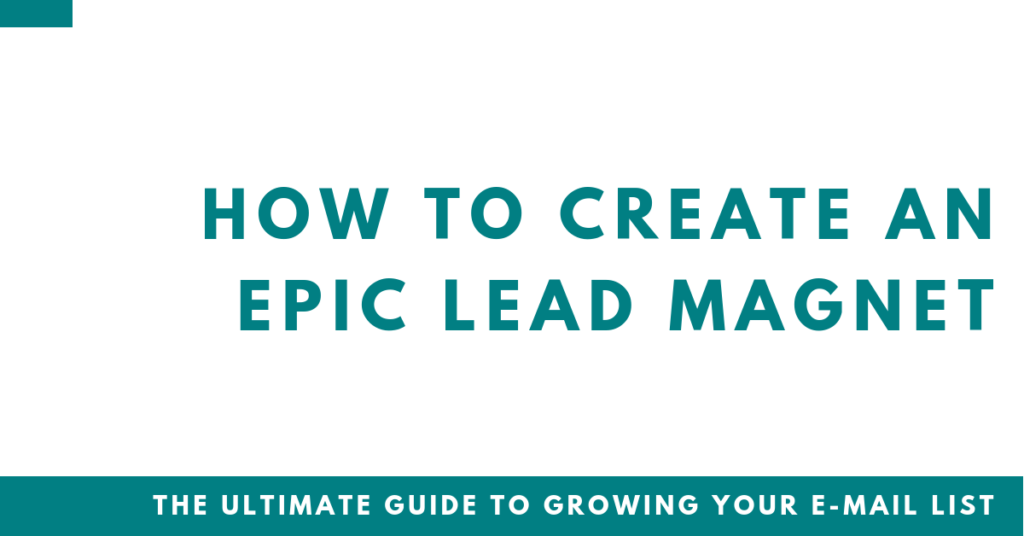
You’re currently reading Chapter 6 of The Ultimate Guide to Growing Your E-mail List.
Your Epic Lead Magnet: The Solution to The Problem Worth Solving
Once you’ve identified the Problem Worth Solving, you’ll want to create an Epic Lead Magnet that solves that problem for your audience better than anyone else on the internet.
You’ll then share your resource with your First 100 Fans and spread the word about it across the internet to grow your e-mail list to 500-1,000 e-mail subscribers.
This Lead Magnet will become the first thing any new e-mail subscriber sees and gets as a gift once they sign up to your e-mail list (some people like to call this an “opt-in offer” or a “freebie”), which will help you turn your website visitors into Raving Fans.
You’ll use your lead magnet every time you publish a piece of Remarkable Content to convert your readers into e-mail subscribers.
You can also use your Lead Magnet whenever you pursue Win-Win Partnerships like Guest Posting or Podcast interviews to give as a gift to your new readers (and maximize the number of new e-mail subscribers you get through these opportunities).
Having an Epic Lead Magnet will also be the key element of creating a High-Converting Website (that will help you make sure as many of your website visitors as possible become your e-mail subscribers).
In this post, you’ll find:
- The 3 Crucial Rules for Creating an Epic Lead Magnet
- 16 Epic Lead Magnet Examples
- How to Create Your Epic Lead Magnet in 9 Easy Steps
Plus two advanced tips for creating Epic Lead Magnets.
Let’s dive in!
What is an Epic Lead Magnet?
The Epic Lead Magnet is a resource you can share with your e-mail subscribers in exchange for their e-mail address. It could be an e-book, a free online course, or something else (we’ll cover many different examples later on in this post).
For example, when you visit my website, you’ll be able to get a free copy of my Ultimate Guide Checklist, which shows you how to grow your blog audience with Ultimate Guides like this one.
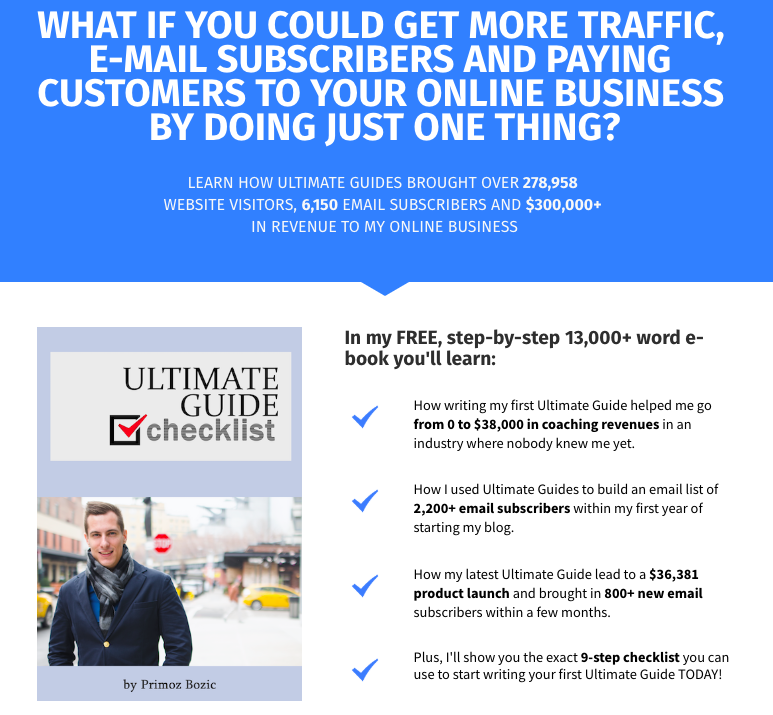
You’ll want to offer an Epic Lead Magnet to your website visitors because a lot more people will subscribe to your e-mail list if you give them something tangible in exchange for their e-mail address (rather than just asking them to “subscribe to your newsletter”.
The “opt-in rate” (the metric that you use to measure how well your Lead Magnet is working) of “subscribing for updates” is usually less than 1-2%, which means that for every 1,000 website visitors, you’d get 10-20 new e-mail subscribers.
On the flip side, having an Epic Lead Magnet can result in opt-in rates of 5-20%, though I’ve seen rates as high as 50%. This means that for every 1,000 website visitors, you’d get 50-200 e-mail subscribers (which would mean that your e-mail list will grow a lot faster).
Another benefit of creating an Epic Lead Magnet is that if you make it REALLY good, your e-mail subscribers will share it with other people, bringing more e-mail subscribers your way via word of mouth.
What Should You Give Away as Your Epic Lead Magnet?
As you might have noticed, my favorite Epic Lead Magnets to give away are Ultimate Guides (like this one), because I’ve found that they work extremely well for converting website visitors into e-mail subscribers and blowing them away with the quality of my content.
I’ve seen others give away free courses, webinars, checklists, tools, calculators, and more.
There are no set rules for what format your Epic Lead Magnet should have.
It could be an e-book, a video, audio, a resource that your e-mail subscribers can “plug and play” to use… It doesn’t really matter.
3 Crucial Rules For Creating Your Epic Lead Magnet
There are 3 things that matter A LOT more than the actual format of the resource. I call these the 3 crucial rules for creating your Epic Lead Magnet.
Rule #1: Your Lead Magnet MUST Solve a Problem Worth Solving
After I published my Ultimate Guide to Creating Bulletproof Habits which helped me get from 0-600 e-mail subscribers in under 2 months, I had an idea to create a “Time Management Workshop”, because I thought my readers would find that more valuable.
I was wrong. When I started offering the workshop on my website instead of the habits guide, a lot less people subscribed to my website, losing me hundreds of e-mail subscribers over the next month.
The mistake that I made was that I created something that I thought was important, rather than solving a Problem Worth Solving for my audience.
If you create an Epic Lead Magnet that isn’t based on the research you’ve done around a Problem Worth Solving, it’s likely that your opt-in rate will tank and you’ll struggle with converting your website visitors into e-mail subscribers.
Luckily, you already know how to do that from the previous chapter of this guide.
Rule #2: Your Epic Lead Magnet Should be The Logical Next Step for The Content You Plan on Creating
Once you create your Epic Lead Magnet, you’ll use it to bring in more e-mail subscribers through your future content (blog posts, YouTube videos, Guest Posts, Podcast interviews, or whatever other method you’ll use to bring in new website visitors).
As you’ll do that, you’ll want your Epic Lead Magnet to be congruent with the content you create.
Here’s what I mean.
Right now, I’m writing this Ultimate Guide to Growing Your E-mail List, and once it’s finished, I’ll create a PDF version of it to use as an Epic Lead Magnet on my website.
Every time I write an article related to growing your e-mail list in the future (like “how often should you e-mail your e-mail list?”), I’ll offer this guide to the readers as the logical next step in their journeys.
If you’re reading about how often you should be emailing your e-mail list, you’ll likely want to know how to grow your e-mail list as well, so my opt-in rate from those articles should be pretty high.
On the other hand, if I wrote a guide on Mental Toughness for online entrepreneurs, it wouldn’t really be as relevant to the readers of the article, which is why my opt-in rate would be lower.
That’s why it’s important to do a bit of planning in advance and make your resource broad enough that it can be related to the future content you create.
Rule #3: Your Epic Lead Magnet Should be so Good You Could Charge for it
Some people say that your “lead magnet” can be super simple, like a simple one-page checklist.
I disagree.
I’ve found that while you CAN convert readers into e-mail subscribers with a simple checklist, it’s not the best idea to do that, especially when you’re just starting out with growing your e-mail list.
Instead, I believe that your Epic Lead Magnet should be so good you could charge for it.
Here’s why:
- When you’re still “unknown” in your industry, creating a really outstanding Epic Lead Magnet can help you get noticed and “known for something”
- If your “over-deliver” with your Epic Lead Magnet, your readers and e-mail subscribers will spread the word about it for you and share it with their friends
- If your new e-mail subscribers are blown away by your Epic Lead Magnet when they subscribe to your e-mail list, they’re a lot more likely to stay subscribed and buy your products and services because they’ll think to themselves, “wow, if his free content is so good, then the paid content must be even better!”
- Now that the online business space is more and more competitive, you want your content to stand out as the best content out there, to have a competitive advantage
- When it comes to spreading the word about your Epic Lead Magnet, you’ll be A LOT more confident in talking about it if you know it’s your best work (and overcome your fear of self-promotion and putting yourself out there)
You’ll notice that many of the entrepreneurs I interviewed for this guide share the same mentality as we look over their Epic Lead Magnets, and for many of them going that extra mile really paid off.
One extreme example that comes to mind is an entrepreneur that created a full 30-hour online course, and gave it away to his e-mail subscribers for free (even though he could easily charge $500 for an online course like that). He did what nobody else would do.
Because this free course was unlike anything else out there, the people who went through it shared it with their friends, and in a bit over a year, he went from 0-3,500 e-mail subscribers.
Another great example is Jenni Waldrop, who went from 150 to 4,000+ e-mail subscribers in just a few months by creating an amazing Epic Lead Magnet for her website visitors. During our interview, Jenni said that your opt-in shouldn’t be a crappy checklist – it should be the best thing you’ve ever done.
Another example is Sam Gavis-Hughson, who spent 4-5 months creating his Epic Lead Magnet (a free e-book on mastering coding interviews) on the side of a full time job. As he published it, he went from 400 e-mail subscribers to 1,200 e-mail subscribers practically overnight, and kept adding 200+ new e-mail subscribers to his e-mail list every month since.
Creating an outstanding Epic Lead Magnet takes time, but it’s well worth the effort in the long-run.
16 Epic Lead Magnet Examples
To give you an idea what kind of Epic Lead Magnets you could create, I put together a list of 16 resources that you can study and analyze.
Here they are, in no particular order:
- Dynamic Programming for Non-Geniuses: E-book by Sam Gavis-Hughson
- 50 Practice Questions For Your Coding Interview: E-book by Sam Gavis-Hughson
- Ultimate Guide To Selling on Etsy: Ultimate Guide by Jenni Waldrop
- Etsy Shop Critique Challenge: Challenge by Jenni Waldrop
- SEO Bootcamp: Bootcamp by Jenni Waldrop
- Double Your Frenchness Crash Course: 10-day course by Geraldine Lepere
- American Accent Survival Kit: Resource Pack by Christina Rebuffet
- 5 Secrets to Writing Your Book Quickly: Cheatsheet by Vickie Gould
- The Essential Summer Style Guide: Ultimate Guide by Peter Nguyen
- 5 Beginner Basslines: Resource Pack by Luke McIntosh
- Ultimate EDM Speed-Writing Cheat Sheet: Cheat Sheet by Will Darling
- Best Hacks for Making Money on Upwork: E-book by Danny Margulies
- The Ultimate Guide to Sentence Structure: E-book by Karen Dudek-Brannan
- 7 Spicy Recipes to Melt Off 7lbs: Recipe book by Nagina Abdullah
- Top 3 Mistakes That Crush Your Chances With a Studio: E-book from Rusty Gray
- Ultimate Guide Checklist: Checklist by Primoz Bozic
As you can see, there is a variety of resources, though the most popular Epic Lead Magnets seem to be guides and e-books.
How to create your Epic Lead Magnet in 9 easy steps
Now that we looked at why you need an Epic Lead Magnet to make your Big Entrance and grow your e-mail list to 500-1,000 e-mail subscribers, let’s talk about how to actually create one, step by step.
Step #1: Identify a Problem Worth Solving
You already know how to do this from the previous chapter of this guide :). Talk to your First 100 Fans, see what challenges they’re having, and pick a common challenge that you’d love to solve for them.
Problems Worth Solving could be:
- Getting invited to speak at a TEDx event
- Growing your e-mail list
- Learning how to edit photos in photoshop
I’ll use these as examples to show you how to turn these Problems Worth Solving into Epic Lead Magnets.
Step #2: Define a Tangible Result
Once you know what the Problem Worth Solving is, think of a tangible result you want to help your e-mail subscribers achieve after they work through your Epic Lead Magnet:
- If the Problem Worth Solving is getting invited to speak at a TEDx event… The Tangible Result could be actually getting invited to speak at a TEDx event
- If the Problem Worth solving is growing your e-mail list, the Tangible Result could be getting to your first 1,000 e-mail subscribers
- If the Problem Worth Solving is learning how to edit photos in photoshop, the Tangible Result could be learning how to beautifully edit a photo in under 15 minutes
Defining a Tangible Result will help you write Mouthwatering Opt-in Copy, as well as get clear on what your Epic Lead Magnet should actually include.
“What about Intangible Results?”
One of my readers had an interesting follow up chapter to this section of the guide, so I decided to include it here:
The thing is the blog I’m thinking to open would be around the more psychological side of the business (like motivation, self-doubt, courage, why and how we make choices, etc.) and I’m having a harder time coming up with actionable tactics I can package in a catchy lead magnet.
You can absolutely create a Lead Magnet around Intangible Results!
Here’s a great example from Mark Manson (a guide to happiness):
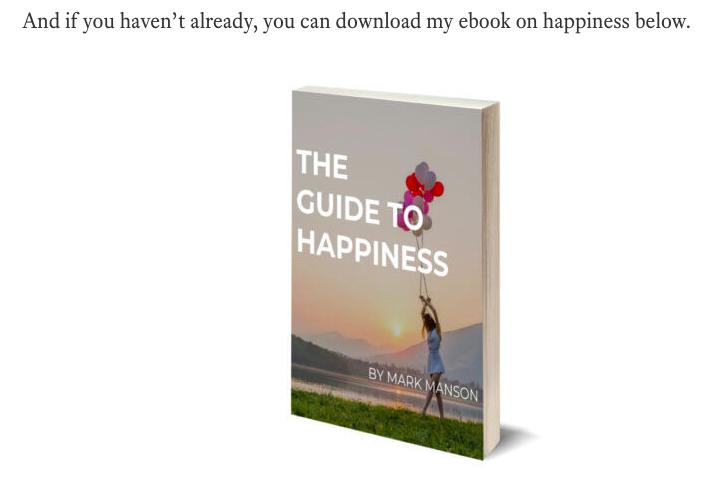
I can instantly think of:
- The Ultimate Guide to Motivation
- The Quick Guide to Overcoming Self-Doubt
- The 80/20 Guide to Becoming More Courageous
(I like to think in guides, but your Lead Magnets could be of a different format as well).
As far as Building Blocks go, you can think of tactics that provide an instant effect in being more motivated, happier, more courageous, etc.
You could also read a few books on these topics and see how they do it (the best books on any topic are usually full of sticky ideas).
Step #3: Brainstorm the Building Blocks
Once you have clearly defined a Tangible Result, you can plan out which Building Blocks you’ll need to create an Epic Lead Magnet that will help your e-mail subscribers get the result you’re promising them:
- What do you need to teach them?
- What do they have to do?
- What resources will be helpful for them?
You’ll want to think of the BEST possible way that you can help your e-mail subscribers get to the outcome that you want to help them achieve.
If I want to help someone get invited to speak at a TEDx event, I might want to:
- Show them what the process for getting invited to speak at a TEDx event looks like
- Tell them which mistakes most candidates make (that they’ll want to avoid)
- Give them specific strategies they can use to “pitch themselves” to a TEDx event
If I want to help someone grow their e-mail list to 1,000 e-mail subscribers, I might want to:
- Tell them what’s the “high-level strategy” to get there
- Give them specific list-building tactics and strategies they can implement today
- Include specific templates and resources to help them along the way
If I want to help someone edit photos in photoshop, I might want to:
- Show them the 3 beginner editing tools that they should learn how to use
- Teach them how to use each of the 3 tools
- Explain the basic process for editing your photos, and how to go through each step of the process
(Note that I have no experience with photoshop so I’m making these up, but you get the point).
33 Real-World Examples of Building Blocks
Here are 33 additional examples of “Building Blocks” you can use as inspiration (I pulled these from real Epic Lead Magnets of entrepreneurs I interviewed for this guide).
Your Building Blocks could be…
Tricks or hacks:
- The tricks all top sellers know to keep sales flowing (tricks)
- THE ONE SIMPLE TRICK to wearing more color (even if you’re “not a color guy”) (trick)
- The one hack that earned me over $30,000 over the course of a couple of years (and takes just 3 minutes to execute) (hack)
- A profile trick that’s scientifically proven to help you win more jobs (at higher prices) (trick)
- The deeply psychological hack I used to raise my rates by $50 per hour overnight (hack)
- How to make a few simple changes that will bring you more views and customers (quick changes)
Lessons, tutorials, explanations or walkthroughs:
- The exact strategies to approach each problem (and others like them) with step-by-step video walkthroughs (video walkthroughs)
- Pronounce the expressions correctly, thanks to my explanations in the complete video lesson (video lesson)
- How to finally “get” what Dynamic Programming really is (explanation of a difficult concept)
Examples (Questions, Recipes, Clothing Items, Outfits, Expressions, Mistakes, Common Problems, Myths, Misconceptions…):
- 50 real-world interview questions that were asked in actual interviews (interview questions)
- Recognize 12 everyday expressions when Americans say them fast…without translating in your head (expressions)
- 13 MUST HAVE ESSENTIALS every man needs in his summer wardrobe (specific clothing items)
- 7 ULTRA-VERSATILE pieces all guys should have this Spring that you can wear to the office and on the weekend (specific clothing items)
- EXACT outfit “recipes” for all your important events – from business casual meetings to your best friend’s wedding (outfits)
- 7 Spicy Recipes to Melt Off 7lbs (recipes)
- Discover “the top 3 mistakes that crush your chances with a studio” and make your dream job happen. (mistakes)
- The 4 sentence types often behind comprehension and expression issues and why they’re so difficult. (sentence types)
- The most common problems that hold most all sellers back (and how to fix them!) (common problems)
Crucial Information:
- The only 10% information you need to ace your interview (the 80/20 rule)
- What you REALLY need to do to succeed on Etsy (the 80/20 rule)
- The most important element to include to turn readers into clients (80/20 rule)
Techniques, Formulas, Strategies or Tactics:
- The not-so-obvious way you can solve any dynamic programming interview fast (counterintuitive technique)
- My 5-step formula for acing each and every whiteboard interview (formula)
- What you need to add into your book to make it a page-turner (key strategy)
- How to add more colors and prints to your wardrobe, without looking like an Easter Egg (technique)
- The deceptively simple way to write language goals; so you’re not spending hours on paperwork (goal bank included). (technique, goal bank)
- An easy-to-implement “low-prep” strategy proven to boost sentence structure, comprehension, and written language (conjunctions flashcards included). (strategy)
Tests, Quizzes, Cheat Sheets or Worksheets:
- Train your ear to instantly catch the fast sounds, with the audio test and worksheets (test + worksheets)
- Download my free Ultimate EDM Speed Writing Cheat Sheet below, and get your track finished TODAY! (cheat sheet)
Hidden Opportunities, Secrets or Counterintuitive Advice:
- What opportunities open up for you with a book (and what you’re missing without one) (hidden opportunities)
- Pro secrets to creating content for your book in less time (secret)
- The hidden culprit behind unexplained “processing” problems that’s often overlooked. (secret issue)
- How wearing LESS clothes can make you FEEL HOTTER! (And what to do instead) (counterintuitive advice)
Step #4: Choose the Format
Once you have your Building Blocks ready, you can decide on the format of your Epic Lead Magnet.
This could be:
- An e-book or a guide
- An e-mail course
- A video course
- A video workshop / masterclass
- A collection of scripts / examples
- …or something else
You should pick a resource format that best suits what you’re trying to teach:
- An e-book would be great for teaching someone how to get invited to speak at a TEDx event
- An Ultimate Guide would be great for helping someone grow an e-mail list
- A 5-day course with video tutorials would be great for teaching someone how to edit photos in Photoshop
Chances are that you could pick different formats for the same Epic Lead Magnet (for example, if you could write an e-book about something, you could also create a video course about it).
I suggest picking the option that is:
- Easier to implement and set up (creating a PDF e-book might be easier than creating a 5-day video course)
- The most exciting (you want to be excited about creating your Epic Lead Magnet)
- Plays to your strengths (if you love writing, write an e-book; if you love talking, record a video workshop)
Remember, the format isn’t as important as nailing the other steps of this process. Pick a format that will work and move on!
Step #5: Create an Outline
Once you’ve selected the format of your Epic Lead Magnet, you can create a simple outline for your Epic Lead Magnet.
During the outlining stage, you can simply organize all of your Building Blocks into an order/flow that makes the most sense, so that you can move forward with creating the resource.
Here’s an example from such an outline from my Ultimate Guide to Creating Content That Sticks:
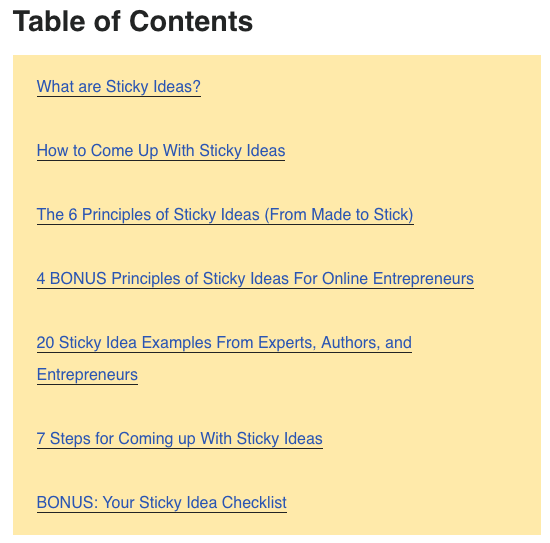
As you can see, the outline is simple and to the point – don’t overcomplicate this step!
Step #6: Go the Extra Mile
Once you have a simple outline in place, take some time to think about how you can go the Extra Mile for your e-mail subscribers and really make your Lead Magnet Epic and one-of-a-kind.
This is one of the most important steps in this process (right after finding a Problem Worth Solving), as this step will make your resource really stand out from everything else out there (and lead to your readers loving it and sharing it with their friends).
For this guide, I went the Extra Mile by actually interviewing 20 entrepreneurs about how they grew their e-mail lists, rather than just summarizing my own personal experiences.
I’m also going the Extra Mile by pulling real-world examples for things like Finding Profitable Business Ideas, Epic Lead Magnets, Writing Mouthwatering Opt-in Copy, etc.
For a guide on TEDx talk, I might:
- Interview a few TEDx event organizers and ask them what makes the best candidates
- Interview past TEDx speakers and ask them how they got invited to events
- Break down “good” and “bad” approaches or pitches
- Record and share an actual interview with a TEDx organizer
- Figure out if there are different “tiers” of TEDx events and break down what you need to land a speaking opportunity at each of the different tiers
And for a Photoshop editing video course, I might:
- Record 5 example videos for each editing tool where I use the tool on 5 different images
- Talk about common exceptions / edge cases (like having an extremely bright/dark photo) and how to handle them
- Create an “editing checklist” or “cheat sheet” that my readers can keep in front of them as they edit their photos for easy reference
Think about what going the Extra Mile would look like for your readers, and make it happen!
And if you don’t know what going the Extra Mile would look like, you could just e-mail them and ask them:
“Hey NAME,
I’m working on a resource that will help you get a speaking gig at a local TEDx event. To make this resource as valuable as possible to you, could you let me know what’s one thing I could include in the resource that would make it insanely valuable to you?
Thanks,
-YOUR NAME”
Step #7: Create the Lead Magnet
This is the step where you “buckle down and make it happen”.
When you’re creating your first Epic Lead Magnet, I suggest spending roughly 10-20 hours on it (you should be able to create it within a few days or 1-2 weeks at most).
That will be plenty of time to make it Epic while still keeping it manageable.
If you want to learn more about how to create an amazing Epic Lead Magnet, you can read two of my Epic Resources that will help you create one:
- The Ultimate Guide Checklist: Ultimate Guides are some of the best Epic Lead Magnets you can create – and I wrote a detailed guide that covers the exact steps for writing an Ultimate Guide
- The Ultimate Guide to Creating Content That Sticks: Your Epic Lead Magnets are amazing opportunities for creating your own Sticky Ideas and Frameworks that you can become known for (and that will get you even more e-mail subscribers). I wrote a detailed guide on how you can up with those and make your Epic Lead Magnets even better.
Step #8: Pick a Sticky Name
Once you’ve written your Lead Magnet (or as you’re writing or planning it), give it a sticky name!
Calling your resource something (like Jenni Waldrop’s SEO Bootcamp or Christina Rebuffet’s American Accent Survival Kit) will make it more tangible, compelling, stickier and shareable.
While a name won’t make or break your Epic Lead Magnet, coming up with a sticky name can definitely pay dividends in the long run.
Here are some short guidelines for coming up with a sticky name for your Epic Lead Magnet:
- Make it CLEAR: When someone hears the name of your resource, they should instantly know what it’s about. Clear names tend to perform better than fancy names, especially when not many people know you yet.
- Keep it SIMPLE: You should be able to say the name of your Epic Lead Magnet in one breath of air. If your name is confusing, a lot less people will remember it.
- Make it STICKY: If you want to go the extra mile, make your name sticky and memorable. This means that someone should only hear the name of your Epic Lead Magnet once in order to remember it for years.
If you’re not sure how to come up with a great name for your Epic Lead Magnet, definitely read my Ultimate Guide to Creating Content That Sticks – it will give you plenty of ideas plus a specific framework for making your name sticky and memorable.
Step #9: Design it
Unless you’re a designer or want to serve an audience that really values visually appealing e-books, you definitely don’t need to spend any money (or too much time) designing your e-books at an early stage of your business.
Later on when you’re running your business full time and making a decent living off it, you can definitely consider hiring a designer to design your e-books, but until then it likely won’t be necessary.
I personally write and “design” my e-books (by design, I mean that I create a cover and some headings) in Google Documents, then simply export them as a PDF. I stuck with that simple and proven process for years, and it was more than enough to build a 6-figure online business.
If you really wanted to design a nice cover for your Epic Lead Magnet, the only other tool I’d recommend is Canva – there’s a free version and it’s pretty intuitive to use.
Advanced Tip: Create an Epic Lead Magnet Portfolio
As you might have noticed, a lot of established entrepreneurs have more than one Epic Lead Magnet – they have an Epic Lead Magnet Portfolio.
Here’s an example from Peter Nguyen:
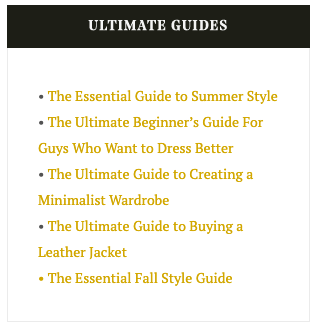
As you e-mail list grows, you might want to create one yourself as well.
The idea behind an Epic Lead Magnet Portfolio is simple – you can create a portfolio of different Epic Lead Magnet for different topics (or audiences).
You will usually want to do that when you start a new Content Season (a concept we’ll talk about in the next chapter of this guide), or in other words, when you start talking about a new topic that you haven’t talked about before.
For example, the reasons why I’m creating this very Ultimate Guide are:
- I want to establish myself as an expert in list-building
- I want to give my readers an amazing resource on list-building, as I know that that is a Problem Worth Solving for them
- I want to create an Epic Lead Magnet that I can use as a logical next step (or a “content upgrade”) for all the future content I create
Peter Nguyen does this exceptionally well. He has dedicated Epic Lead Magnets for spring and summer style and fall and winter style, which he can then offer to his readers whenever he talks about specific clothing items in different seasons.
Jenni Waldrop also created an Epic Lead Magnet Portfolio for her readers, and she did it by simply collecting the top 5 questions from her audience, and then creating an Epic Resource for each of them (for example, since a lot of her readers had questions about SEO, she created the SEO bootcamp).
You probably won’t need to create an Epic Lead Magnet Portfolio until you have thousands of e-mail subscribers, but once it makes sense for you to do it, you can just use the exact steps from this chapter to create another Epic Resource that your readers will love.
Advanced Tip: Create a Content Ladder
Another advanced tip for when you start creating products and services in your online business is to create a Content Ladder for each of the topics that you talk about in your online business where each of your Content Layers builds on a previous layer.
The Content Ladder will look like this:
World Class Content -> Epic Lead Magnet -> Flagship Product or Service
Your new readers will find your content, subscribe to your e-mail list to get an Epic Lead Magnet, and have the opportunity to join your flagship product or service (all related to the same topic).
Here’s a practical example from Christina Rebuffet:
“Every month is dedicated to a different program we are selling in our business. Every YouTube video we create is on a subject related to the program we’re selling, and so are out lead magnets. The subjects we talk about always correlate to the big programs we are selling.”
For example, this is what Christina’s Content Ladder could look like:
- World-Class Content: 6 Secrets to Understanding Fast-Talking Americans
- Epic Lead Magnet: American English Survival Kit
- Flagship Product: Master Real American English
Structuring your content and Epic Lead Magnets you create in this way will help you maximize the amount of paying customers you attract to your business, create a great immersive experience for your readers, and become way more strategic with everything you do in your business.
Summary
Once you’ve identified the Problem Worth Solving, the next logical step is to create a Lead Magnet that you’ll give away to your new e-mail subscribers.
Make sure your Epic Lead Magnet follows the following rules:
- Rule #1: It MUST solve a Problem Worth Solving
- Rule #2: It should be the logical next step for the content you plan on creating
- Rule #3: It should be so good you could charge for it
You can then create the Epic Lead Magnet in 9 easy steps (and use the 16 Epic Lead Magnet examples in this post for guidance):
- Step #1: Identify a Problem Worth Solving
- Step #2: Define a Tangible Result
- Step #3: Brainstorm the Building Blocks
- Step #4: Choose the Format
- Step #5: Create an Outline
- Step #6: Go the Extra Mile
- Step #7: Create the Lead Magnet
- Step #8: Pick a Sticky Name
- Step #9: Design it
To guide you in creating your Epic Lead Magnet, you can read my Ultimate Guide Checklist and The Ultimate Guide to Creating Content That Sticks.
As your e-mail list grows to a few thousands of e-mail subscribers, you can create an Epic Lead Magnet Portfolio to serve different audiences.
And once you start selling online products or services, make sure your Epic Lead Magnets fall correctly into the Content Ladder:
World Class Content -> Epic Lead Magnet -> Flagship Product or Service
That’s it!
Now you know everything you need to know to create an Epic Lead Magnet. Stay tuned for the next chapter, in which we’ll cover how to write Mouthwatering Opt-in Copy for your Lead Magnet.
Continue to Chapter 7: How to Write Mouthwatering Opt-in Copy
Your Turn: What will be the Epic Lead Magnet that you’ll create?
Are you ready to build an e-mail list of 1,000+ BUYERS?

Download the full 393-page PDF version of this EPIC list-building guide, to print it out or read it on the go!

